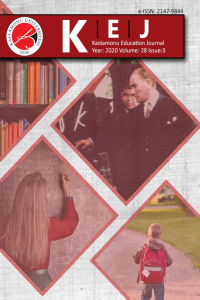Öz
Kaynakça
- Cai, J. (2004). Why do US and Chinese students think differently in mathematical problem solving?: Impact of early algebra learning and teachers’ beliefs. The Journal of Mathematical Behavior, 23(2), 135-167.
- Cai, J., & Ding, M. (2017). On mathematical understanding: perspectives of experienced Chinese mathematics teachers. Journal of Mathematics Teacher Education, 20(1), 5-29.
- Carpenter, T. P., & Lehrer, R. (1999). Teaching and learning mathematics with understanding. In E. Fennema & T. R. Romberg (Eds.), Mathematics classrooms that promote understanding (pp. 19–32). Mahwah, NJ: Erlbaum.
What Is Mathematical Understanding and How Is It Achieved? Preservice Middle School Mathematics Teachers’ Views and Reflections in Their Teaching Practices
Öz
This research was designed to determine the views of preservice middle school mathematics teachers on what mathematical understanding is and how to achieve it, as well as the reflections of these views in their teaching practices. The participants included six preservice teachers studying in the final year of the Middle School Mathematics Teaching Program at a state university in Turkey. The research was carried out during the Teaching Practice course. The data consisted of the lesson plans prepared by the preservice teachers, video recordings of the lessons in which they put those plans into practice, field notes taken during lesson observations, and transcripts of one-on-one interviews with the preservice teachers after the lessons. Participants related mathematical understanding to interpreting situations or problems encountered in daily life mathematically, representing mathematical ideas, answering every question related to the subject, and developing a positive attitude toward mathematics. They began their lessons with daily life examples and then reminded the students of their prior knowledge, presented definitions of concepts, and worked with students on sample exercises using different representations during the lessons. These views and practices are discussed in the context of preservice teachers’ designs of learning environments that promote mathematical understanding.
Anahtar Kelimeler
Mathematics education Preservice mathematics teachers Mathematical understanding
Kaynakça
- Cai, J. (2004). Why do US and Chinese students think differently in mathematical problem solving?: Impact of early algebra learning and teachers’ beliefs. The Journal of Mathematical Behavior, 23(2), 135-167.
- Cai, J., & Ding, M. (2017). On mathematical understanding: perspectives of experienced Chinese mathematics teachers. Journal of Mathematics Teacher Education, 20(1), 5-29.
- Carpenter, T. P., & Lehrer, R. (1999). Teaching and learning mathematics with understanding. In E. Fennema & T. R. Romberg (Eds.), Mathematics classrooms that promote understanding (pp. 19–32). Mahwah, NJ: Erlbaum.
Ayrıntılar
| Birincil Dil | İngilizce |
|---|---|
| Konular | Eğitim Üzerine Çalışmalar |
| Bölüm | Research Article |
| Yazarlar | |
| Yayımlanma Tarihi | 28 Ekim 2022 |
| Kabul Tarihi | 27 Temmuz 2022 |
| Yayımlandığı Sayı | Yıl 2022 Cilt: 30 Sayı: 4 |


